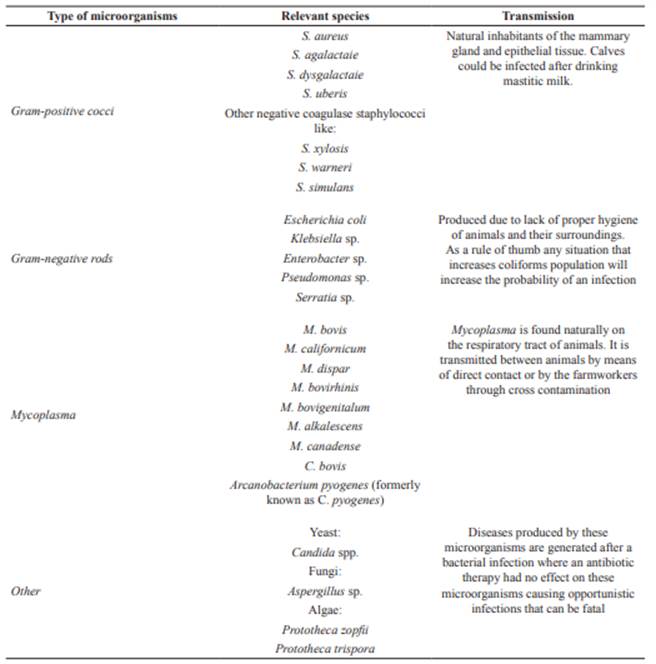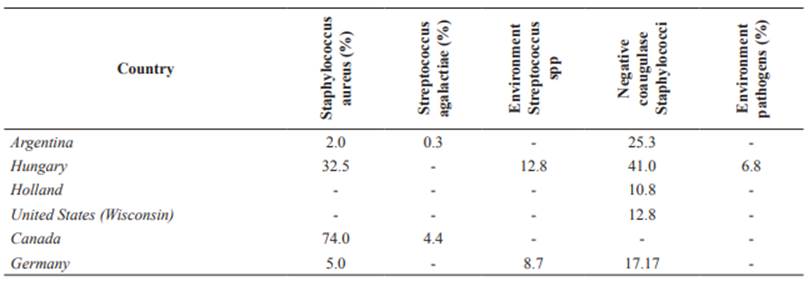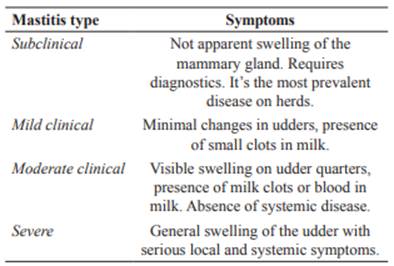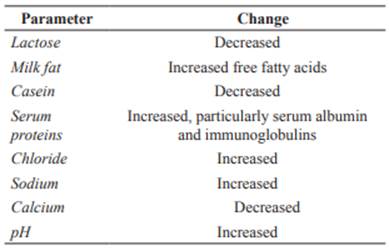Introduction
High somatic cell count (SCC) is an indicator of mastitis in dairy cattle and an indirect measure of the quality of raw milk for the dairy industry. Mastitis is the most common disease in dairy herds and is the leading cause of economic losses in dairy production worldwide (Hogeveen et al., 2011). The composition of milk may be affected by multiple factors, such as breed, age, lactation stage, climate, and animal diet, among others. Mastitis, an inflammatory reaction of the mammary gland, is also known to affect the quantity, quality, and suitability of milk for the dairy industry. Beyond its implications for animal health and food safety, mastitis is a problem for the dairy industry because milk changes result in lower yields, decreased shelf life, poor quality of dairy products, and economic losses for the industry (Le Marechal et al., 2011).
In Colombia, quality-based milk price was established in Decree #616 (Social Protection Ministry, 2006). However, SCC -an udder-health indicator and an indirect measure of raw milk quality- is not considered in this decree, meaning that no official reference limits are considered in the payment system. Consequently, producers do not feel encouraged to lower somatic-cell levels. This results in a disadvantage compared to countries that include this parameter in their payment schemes and have free trade agreements with Colombia, negatively affecting its competitiveness.
This article reviews the literature on the microbiology and etiology of mastitis, and how milk quality and safety are affected by high SCCs. This study seeks to draw attention to the vital importance of developing the dairy sector in Colombia, its effect on farmers, the dairy industry, the country's economy, and -of course- the consumers.
Somatic cells and mastitis
Somatic cells count in milk is an indicator of udder health as these cells protect the mammary gland from infections. The SCC is influenced by many factors, such as animal species, lactation status, individual and environmental factors, and animal management (Pyörälä, 2003).
The four main types of somatic cells (leukocytes) are macrophages, polymorphonuclear neutrophil cells, lymphocytes, and epithelial cells. Mastitis can affect a single udder quarter or several of them. In addition to the udder immune function, somatic cells provide numerous endogenous enzymes (e.g., lipases, oxygenases, proteases, glycosidases). Proteases and lipases have specific activity and, when released into milk, can influence dairy-industry processes related to the transformation of raw milk, neg- atively affecting the quality of dairy products, producing rancidity (Li et al., 2014).
Normal values of somatic cells per udder quarter are between 68.000 and 187.000 cells/mL in bovine milk (Djabri et al., 2002). In contrast, the corresponding values in sick animals are >200.000 cells/mL, varying according to the pathogen causing the infection (Ruegg and Pantoja, 2013). The main microorganisms responsible for mastitis are Corynebacterium bovis, Escherichia coli, Staphylococcus aureus, Streptococcus uberis, and Streptococcus agalactiae (Le Maréchal et al., 2011). Different pathogens induce different symptoms associated with different types of mastitis. Mastitis can be subclinical or clinical, in different ranges, as shown in Table 1.
Legal limits for acceptable SCC levels in the dairy industry vary by country. For example, in the European Union, if cow’s milk has SCCs >200.000 cells/mL, the udder is considered infected. When the SCC is over 400.000 cells/ mL, milk is deemed unsuitable for human consumption. SCC on the tank is 100.000 cells/ mL in Germany, 500.000 cells/mL in Canada, and 750.000 cells/mL in the United States (Ruegg and Pantoja, 2013).
Milk with high SCCs also represents a significant risk to public health. This has been insufficiently studied in developed countries because most milk consumed in such countries undergoes some heat treatment. In Colombia, 43% of the milk produced goes to informal vendors (DNP, 2010) and is mostly used to make artisanal peasant cheese without any heat treatment or pasteurization, thus, presence of pathogens and toxins is highly probable, thereby posing a risk to human health. Listeria monocytogenes in “campesino” cheese -a popular fresh product made in Colombia with unpasteurized milk- has been reported (Duque et al., 2018).
An Increase In SCC Is normally associated with a decrease in milk production in ruminant animals. After clinical mastitis, milk production decreases in the cow and will never return to its normal levels (before mastitis). The percentage of milk yield loss depends on the infecting pathogen (Le Marechal et al., 2011).
Definition of mastitis
Mastitis can be defined as an inflammation of the mammary gland, caused by the growth of pathogenic microorganisms introduced either naturally by the breast canal or by physical means during milking or cleaning of the animal. As microorganisms multiply, they release toxic substances into the mammary gland causing vascular permeability of the tissue, leading to a compositional change in milk due to the entry of blood components such as blood serum, proteins, salts, and enzymes. In turn, casein and lactose production substantially decreases, as is the quality of fatty acids present in dairy fat. These changes affect the taste and quality of milk and dairy products. From a clinical point of view, mastitis is a multifactorial disease, a combination of the glandular defense mechanisms, exposure to pathogens, and environmental factors present at the site (Wellemberg et al., 2002).
Mastitis etiology
The process of infection of the mammary gland can be due to several factors. The presence of dirt or feces in the udder, poor hygiene among the milking staff, poor washing of the nipples in the context of automatic milking, and poor milking practices, among others. Although more than 150 species of microorganisms are capable of infecting the mammary gland (Kuang et al., 2009; Shome et al., 2011; El-sayed et al., 2017), including viruses, yeasts, mycoplasma, fungi, and bacteria, more than 95% of mastitis cases worldwide are caused by about 10 microbial groups (Table 2). S. aureus, S. agalactiae, and S. dysgalactiae are the microorganisms present in most mastitis cases produced by contagion. Among the microorganisms present in the environment, four groups can be identified: Gram-negative microorganisms (E. coli), Corynebacterium, Mycoplasma, and others, such as Nocardia, Prototheca, and some yeasts (Ranjan et al., 2006; Vakkamäki et al., 2017).
S. agalactiae and S. dysgalactiae are obligatory inhabitants of the mammary gland and very easily spread among healthy cows causing subclinical or intermittent mastitis (Mc Dougall., 2002). S. aureus is not an obligatory inhabitant of the mammary gland but can be easily transmitted by sick cows by cross- contamination of milkers or poor cleaning. Once established, S. aureus is difficult to eliminate (Divers and Peek, 2008).
Microorganisms present in the environment, such as E. coli or Mycoplasma, are transmitted horizontally between asymptomatic animals, either orally in lactating calves, by contaminated feces, or by nasal secretions of infected but asymptomatic animals (Punyapornwithaya et al., 2010). Proliferation of such microorganisms is linked to high temperatures, wet surfaces, contaminated bed materials (straw), and poor milking practices, among other factors. Coliforms can enter the breast canal and multiply rapidly in short periods (16 hours), causing an inflammatory response (Divers and Peek, 2008).
Prevalence of mastitis in herds has declined dramatically in recent years due to improved milking practices and health control of farms and animals. It should be noted that mastitis prevalence varies greatly from region to region depending on climate, temperature, livestock breed, and handling at milking sites (Ruegg, 2012; Reyes et al., 2017).
Table 2 Pathogens causing mastitis.

Adapted from Ruegg (2017), Carrillo-Casas and Miranda-Morales (2012), and Hillerton and Berry (2005).
The countries with the lowest incidence of mastitis in Latin America are Argentina and Chile, due in part to the implementation of education for animal handlers along with good agricultural practices and programs aimed at decreasing mastitis prevalence (Calvinho, 2019). In other Latin American countries, studies have examined dairy areas, such as the Arequipa or Huaira Basin in Perú (Velázquez and Vega, 2012), and the province of Córdoba in Argentina (Vissio, 2015). However, it is not easy to obtain up-to-date data on the incidence of mastitis in specific countries, making it difficult to design control policies at the governmental level (Table 3). In Colombia, mastitis incidence has been investigated in the traditional dairy basins, such as Boyacá (Calderón and Rodríguez, 2008; Andrade et al., 2014) and Cundinamarca provinces (Martínez, 2006).
Diagnosis
Mastitis can be diagnosed as clinical mastitis -noticeable due to milk clots, inflammation, discoloration, and fever in the mammary gland- or subclinical mastitis, which is the most prevalent in herds. Subclinical mastitis is challenging to diagnose due to the absence of obvious symptoms, making it a risk factor for the animal and the quality of milk. It should be noted that mastitis can be acute or chronic, producing inflammation episodes that can last for months, leading to fibrotic udder (Nielsen, 2009).
The most effective way to diagnose mastitis is direct somatic cell counting; however, this methodology is not always feasible, because it is labor-intensive and must be done routinely. The gold standard test is somatic cell counting in the industry and the California Mastitis Test (CMT) in farms (Mollenhorst et al., 2010). The latter relates to the amount of DNA present in a milk sample, which correlates with an approximate number of somatic cells; however, this number is not always comparable to that derived from other methods, such as cell counting (Blowey and Edmonson, 2010). Compared to the CMT, direct somatic cell counting is a better indicator of the likelihood of infection of an animal. Counts of somatic cells above 50.000 cells/ mL result in economic losses for the producer, and counts above 500.000 cells/mL indicate a greater than 50% chance of infection in the animal. It is also known that an increase in the number of somatic cells in milk directly affects milk quality (Emanuelson et al., 2009; Viguier et al., 2009), as well as the quality of products derived from it. Alternative methods for early detection of mastitis are electrical conductivity (Addis et al., 2016; 2017), lactose percentage (Frey et al., 2013), lactate dehydrogenase (Chagunda et al., 2006), and acute phase proteins (Shaheem et al., 2016), which indicate the presence of somatic cells and could replace the direct count in the near future.
Table 3 Mastitis prevalence in different countries.

Adapted from Carrillo-Casas and Miranda-Morales (2012).
The use of molecular techniques such as real-time polymerase chain reaction (PCR) has also been used to determine pathogenic bacteria in milk (Shome et al., 2011; Oikonomou et al., 2012; Griffioen et al., 2016; Vakkamäki et al., 2017).
Changes in milk associated with high SCC
The main changes in milk caused by high SCCs are summarized in Table 4.
It can be observed that blood serum proteins (mainly serum-albumins and immunoglobulins) increase, and α and β caseins decrease. There is no such trend for fatty acids; however, some studies report a decreased percentage and quality of fatty acids, with increased free fatty acids (Murphy et al., 2016). Milk pH increases, and sodium, chlorine, and calcium levels decrease. Enzyme activity increases (i.e., plasmin, which is a native protease of milk with an optimal activity of 37 °C present in the udder even before the cow is milked), can hydrolyze α and β caseins. Lipases also are increased, as a result, there are increasing levels of free fatty acids and short-chain fatty acids, leading to defects in dairy products, such as rancidity (Jadhav et al., 2016).
Mastitis affects the quality of pasteurized milk and reduces its shelf life. Raw milk with high SCCs (>700.000 cells/mL) generates taste and odor defects such as rancidity, bitter taste, and astringency in pasteurized milk (Ma et al., 2000). These conditions are attributed to increased lipolysis and proteolysis occurring in milk, which are noticeable between 14 and 21 days of cold storage, decreasing the shelf life of these products. Ma et al. (2000) observed an increase in the amount of total protein, fat, and casein in milk with high SCCs (comparing pre- and post-infection milk), but the increase was explained by a decrease of approximately 30% of the volume of milk produced by the animal. During mastitis, the synthesis of casein and fat in the mammary gland decreases. In Ultra High Temperature (UHT) milk, produced with high SCCs, there were also defects in taste and rancidity due to the growth of bacteria and the proteolysis and lipolysis of milk components (Murphy et al., 2016).
Impact of high levels of somatic cells in yogurt. There are not many studies of high SCCs in yogurt; however, decreased shelf life of this product is due to the appearance of foreign flavors and texture changes during storage. Yogurts produced from milk with counts >800.000 cells/mL had sensory defects and a decrease in consistency after 20 days of storage at 5 °C, attributed to proteolysis generated by the enzymes present due to high SCC (Oliveira et al., 2002).
Impact of high level of somatic cells in cheeses. In cheese products, the impact of high SCCs appears to vary depending on the type of cheese. In short, changes in coagulation properties, increased moisture content in cheese, and development of foreign flavors are the main defects (Le Márechal et al., 2011).
Delay in coagulation times, along with poor curd firmness, low cheese yields, and poor final cheese quality, can be attributed to increased milk pH, decreased lactose, and degradation of casein fractions (Bobbo et al., 2017). In acid coagulation cheeses, the fermentative process is affected by the antimicrobial components produced in mastitic milk, which alter the development of normal aromatic compounds in cheese. Low cheese yields due to high SCCs in milk have been found in Prato, Mozzarella, and Zamorano cheese. High levels of proteolysis in maturation were detected in Swiss and Cheddar cheeses (Le Marechal et al., 2011).
A recent study in Colombia investigated the impact of SCCs on the technological aptitude of milk and the physicochemical and sensory quality of peasant cheese. Milk samples were taken with a range of 150.000 to 1.200.000 cells/mL, and 30 peasant cheeses produced with this milk. The study found a decrease in the technological aptitude of milk with >200.000 cells/mL, increased coagulation time, and decreased yield. The sensory quality was affected by counts greater than 800.000 cells/ mL (Vásquez et al., 2014).
Impact of high levels of somatic cells in powdered milk. The impact of high SCCs is weaker in powdered products. Recently, high SCCs were found to increase particle size in skim milk powder and to decrease its uniformity, affecting its functional properties, such as solubility, dispersibility, and wettability (Sert et al., 2016).
The problem of high somatic-cell levels in Colombia
Money losses due to mastitis have been calculated in studies carried out in the United States. Unfortunately, no studies have been conducted in Colombia to quantify the economic losses due to this disease. Annual livestock guild losses are even harder to calculate. On the other hand, the quality-based milk payment system in Colombia does not include SCCs; therefore, only some farmers are receiving money as bonuses upon the quality payment system. Colanta, a Colombian dairy company, recognizes bonuses for milk with <400.000 cel/mL and pays a higher price for milk with <200.000 cel/mL (Agrocolanta, 2020). For the farm, economic losses include decreasing milk yield, animal losses, increases in veterinary costs (assistance and antibiotics), management costs, etc. Additionally, the dairy industry losses money by receiving milk with high SCCs due to decreased shelf life, product yields (especially cheeses), and loss of sensory attributes. The dairy industry cannot produce high-quality products unless it receives high-quality (microbiologically and compositionally) raw milk. Heat treatments do not improve milk received on the dairy platform; a more internationally competitive dairy sector can come about only with clear governmental support in terms of sectorial policies and commitment of dairy farmers.
The vast majority of milk produced in Colombia is processed by few companies: Colanta, Alpina, Alquería-Freskaleche, Parmalat, and Gloria Colombia (SIC, 2013). These companies have livestock development departments that strive to improve the quality of milk they receive and manage their quality standards based on Colombian regulations. Being close to the dairy basins, which have specialized livestock (for example, in Antioquia), they receive milk with good production standards (approx. 16.46 L of milk/cow/day) and good quality (<100.000 CFU/ mL and 250.000 cells/mL on average; Barrios and Oliveira, 2013). However, other provinces, such as Sucre, do not have the same standards. Romero et al. (2018) reported between 530.000 and 624.000 cel/mL. Only 20.6% of the total raw milk samples tested had <400.000 cel/mL. Other researchers analyzed raw milk samples from a Colombian dairy company in 11 collection centers (i.e., around Bogotá, the Middle Magdalena Valley, the Viejo Caldas region, the Antioquia province, and the Atlantic coast), reporting that 41.8% of the tanks had <400.000 cel/mL and only 11.03% had <200.000 cel/mL (Vásquez et al., 2012). More recently, Aldana et al. (2019) found SCCs between 230.000 and 338.000 cel/mL in 27 farms in Anaime-Cajamarca (Tolima province).
Other countries that have included SCC in their quality-based milk payment system have markedly improved raw milk quality. Since 1995, Chile has applied a scheme of payment where SCC was incorporated to improve raw milk quality aiming to reach high quality standards. Statistics of some Southern Chile dairy industries show that average SCC diminished from 460,000 to 330,000 cell/mL from 1997 to 2000, and the same trend was observed from 2001 to 2011: average SCC was 161,131 cell/mL of milk, while in 2017 raw SCC was 151,518 cell/mL (Sebastino et al., 2020). In Brazil, Botaro et al. (2013) found that financial rewards induced changes in milk quality at the central dairy cooperative in south Brazil decreasing counts in bulk tank SCCs and total bacteria. Furthermore, SCC has gained international relevance for the dairy industry worldwide due to the inclusion of this item as a requisite for any export of dairy products and derivatives (<400.000 cel/mL). Therefore, many countries have established quality-based milk payment systems that include this feature (More, 2009).
In Colombia, 43% of milk is marketed informally. Provinces with high levels of informality (over 60%), such as Cauca, Huila, Tolima, Valle del Cauca, Sucre, Santander, Norte de Santander, Meta, and Casanare, where productivity per animal is low (4.5 L/cow/day) also have low raw milk quality (DNP, 2010). Artisanal cheese is the main product of milk informally marketed, and 60% of this cheese is used in bakery products (e.g., achiras, arepas boyacenses, and almojábanas). The small factories processing this milk do not have good quality standards, and the National Agency for the Control of Food and Medicines (INVIMA) usually gives them unfavorable or pending concepts (FEDEGAN, 2013).
As long as the government, dairy farmers, industry, and other stakeholders do not agree to establish a fair payment based on quality, the quality of raw milk in Colombia will not improve. On one hand, The National Dairy Council, who advises the Colombian government, is questioned due to the prevalence of dairy industry members over farmers, generating unfair decisions related to the price of raw milk. On the other hand, livestock owners and farmer associations argue that they want an international market-tied fare (Contexto Ganadero, 2017; 2018). Thus, more effort is required from the government, research centers, universities, and stakeholders to improve the quality of raw milk produced in Colombia. It is important to emphasize that provinces with high informality must improve their standards, productivity and quality of raw milk. This could lead to better economic returns, generating greater development in these regions and the sector as a whole. Studying and disseminating the impact of high SCCs on cheese yield in Colombia and on shelf life of dairy products could elicit greater attention from the government and the dairy industry to establish official limits for SCCs and its legislation as part of the quality payment systems.
















